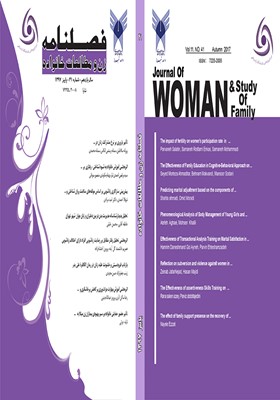بررسی رابطه میزان استفاده از لوازم آرایشی و مزاحمت های خیابانی برای زنان: مورد مطالعه استان کرمانشاه
محورهای موضوعی : زن و خانواده
1 - دانشیار گروه جامعه شناسی، واحد اسلام آبادغرب، دانشگاه آزاد اسلامی، اسلام آبادغرب، کرمانشاه، ایران.
a.moradi@gmail.com
کلید واژه: زنان, مزاحمت های خیابانی, لوازم آرایشی,
چکیده مقاله :
چکیده هدف اساسی این مقاله، بررسی رابطه بین میزان استفاده از لوازم آرایشی و مزاحمت های خیابانی برای زنان شهر کرمانشاه است. این پژوهش با استفاده از روش پیمایش و از طریق ابزار پرسشنامه استاندارد شده انجام شد. جامعه آماری مورد مطالعه زنان بین سنین 14 تا 50 سال استان کرمانشاه می باشد که تعداد 730 نفر از جامعه آماری به شیوه تصادفی طبقه ای برای مطالعه انتخاب شدند. از اعتبار صوری برای روایی و آلفا کرونباخ برای پایایی ابزار پژوهش استفاده به عمل آمد و از روش های آماری ضریب همبستگی پیرسون و تحلیل واریانس برای آزمون فرضیات و تکنیک رگرسیون برای سنجش مدل پژوهش استفاده شد. براساس یافته های پژوهش، بین متغیرهایی چون میزان استفاده از لوازم آرایشی و ابعاد پنج گانه میزان مزاحمت های خیابانی رابطه معناداری وجود دارد. هم چنین نتایج نشان می دهد که نوع آرایش، سطح تحصیلات، وضعیت شغلی، سن و شهر محل سکونت بر میزان مزاحمت های خیابانی تأثیر معناداری دارد. نتایج حاصل از رگرسیون چند متغیره نشان می دهد چهار متغیر میزان استفاده از لوازم آرایشی، نوع آرایش، سطح تحصیلات و شهر محل سکونت توانسته اند 44 درصد از تغییرات درونی متغیر وابسته را تبیین نمایند.
Reference
Adamian, M., Azimi, H. and Sanaati Sharghi, N. (2012). Sociological Analysis of Women's Dress Styles, Journal of Women and Society, Vol. 3, No. 4, pp 23-41.
Bovone, L. (2006)," Urban style cultures and urban cultural productioninMilan": Postmodern identity and the transformation of fashion.
Bowman, C. G. (1993).”Street harassment and the informal gettoization of women”, Harvard Law Review, Vol. 106, No. 3, pp: 517-580.
Craik, J., (2005), Uniforms Exposed: From Conformity to Transgression. Berg, Oxford.
Dehkhoda, A. A. (1978), Dictionary, Tehran, University Press, Tehran.
Fazeli, M. (2004), "Consumption and lifestyles", Tehran: Pub the True dawn. [Persian]
Ganetz, H. (1995)"The sociololoy of Yoth", Ormskrik: Causeway press
Gardner, C. B. (1995), passing by: Gender and public harassment. Berkley, CA: University of California Press.
Gardner, C. B. (1995). Passing by: Gendre and public harassment (Berkeley: University of California Press).
Ghanbari, S. (2007), "reviews the evolution of the discourse of the veil inthe Iranian press 70", Thesis in M.A Sciences and Economics College. Alzahra University. [Persian]
Giddens, A. (2006). Sociology, Translation by Hassan Chavashian, Tehran, Publishing.
Iman, M. T.; Elham Y. and Hosseinzadeh, M (2011), Women, Harassment and Reaction: Student Girls' Experiences of Street Interference and Response to It, Journal of Sociology, Vol. 12, No. 3, pp. 63-93.
Kalantari M.; Ghizelbash, S. and Haji Malaieri, P. (2009), Spatial Analysis and Zoning of Zanjan's Crime Scenes Using the GIS System (Case Study: Victim of Street Intrusion), Zagros Landscape Quarterly, Vol. 1, No. 2, pp. 133-147.
Kearl, Holly (2011), Street harassment of women: It's a bigger problem than you think.
Khajeh Noori, B., Rohani, A. and Hashemi, S. (2011), Lifestyle and Body Management, Journal of Journal of Women's Sociologists, Vol. 2, No. 4, pp. 21-47.
Lahsaei Zadeh, A. and Yousefy, E. (2011). The Relationship Between Adoption of Gender Norms and Street-Interference Experiences: A Case Study of Shiraz University Girl Students.
Lenton, R., M. D. Smith, J. Fox & N. Morra (1999), "Sexual harassment in public: Experiences of Canadian women". CRSA/RCSA, 36/4pp: 517-540.
Lenton, R., M. D. Smith, J. Fox & N. Morra (1999).” Sexual harassment in public places: Experiences of Canadian women”, CRSA/RCSA, 36.4.
Lin, N. (1974). “Foundation of Social Research”, New York: MC Graw. Hill.
Maggie, H. and Gamble, S. (2003), The Culture of Feminist Theories, Translating Firoozeh Mohajerf, Noushin Ahmadi and Khorasani, Farrokh Karadeh, Tehran: Publishing Development.
Movahed, M.; Ghaffari Nasab, E. Hosseini, M. (2010). Make-up and Life of Young Girls, Women in Development and Politics (Women's Research), Vol. 8, No. 1, pp. 105-79.
Parish, W. L., A. Das & E. O. Laumann (2006). “Sexual harassment of women in urban China”, Arch Sex Behave, 35, pp: 411- 425.
Sahabi, J.; Feizi, E. and Samadi Baig Jon, J. (2009), "The Impact of Social Elements on Social Security in Sanandaj City", Social Sciences Research, Vol. 3, No. 3, pp.155-182.
Sigal, J. & H. Jacobsen (1999).”A cross-cultural exploration of factors affecting reactions to sexual harassment: Attitudes and policies”. Psychology, Public Policy and Law, Vol. 5, No. 3, pp: 760-785.
Veblen, T. (2005). The theory of business enterprise, New York, Kosimo Classice.
Voget, D., T. A. Bruce, A. E. Street & J. Staford (2007), "Attitudes toward women and tolerance for sexual harassment among reservists". Violence against women, 13,879.

